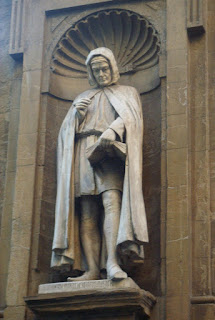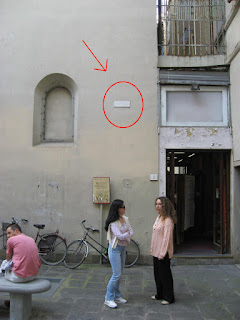Saved hundreds of artworks damaged by Arno floods
 |
| Umberto Baldini |
Umberto Baldini, the art historian who helped save hundreds
of paintings, sculptures and manuscripts feared to have been damaged beyond
repair in the catastrophic flooding in Florence in 1966, died on this day in
2006.
Baldini was working as director of the Gabinetto di
Restauro, an office of the municipal authority in Florence charged with
supervising restoration projects, when the River Arno broke its banks in the early
hours of November 4, 1966.
With the ground already saturated, the combination of two days of torrential rain and storm force
winds was too much and dams built to create reservoirs in the upper reaches of
the Arno valley were threatened with collapse.
Consequently thousands of cubic metres of water had to be
released, gathered pace as it raced downstream and eventually swept into the city
at speeds of up to 40mph.
More than 100 people were killed and up to 20,000 in the valley left homeless. At
its peak the depth of water in the Santa Croce area of Florence rose to 6.7
metres (22 feet).
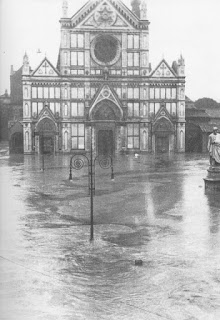 |
| The Basilica of Santa Croce partially submerged under flood water |
Baldini was director of the conservation studios at the Uffizi,
the principal art museum in Florence and one of the largest and most well known
in the world, where some of the most precious and valuable treasures of the
Renaissance were kept, supposedly secure and protected.
The main galleries on the second floor of the Uffizi
complex, situated just off Piazza della Signoria in the heart of the city and
right by the river, escaped but the water – not only muddy but full of oil
after tanks in its path were ruptured – poured into storerooms, where more than
1,000 medieval and Renaissance paintings and sculptures were kept.
Once the flood subsided, it was Baldini’s task to save what
he could from the mess that remained, with everything in the storerooms covered
in oily mud. Similar scenes confronted
the wardens and curators of churches, libraries and museums all over Florence.
It was estimated that between three and four million books
and manuscripts were damaged, as well as 14,000 works of art.
Baldini not only oversaw a painstaking restoration project
at the Uffizi, he was called on to advise in similar efforts taking place
across the city, with almost every church possessing priceless works by one Old
Master or another.
The bespectacled academic called in experts from around the
world and rapidly organised the hiring and training of hundreds of volunteers –
the so-called Mud Angels – to dry, clean and restore such damaged material as
could be salvaged.
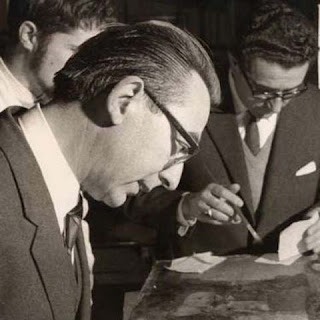 |
| Baldini examines some of the restoration work |
Books were washed, disinfected and dried, pages often removed
to be later rebound. Paintings were dried with the application of rice paper,
with techniques employed in some cases to remove entire paint layers and
reapply them to a new surface.
The work went on for decades after the streets had been
cleaned up and Florentine life restored to normal but by the mid-1980s it was
thought up to two-thirds of all the damaged items had been repaired, including
high-profile casualties such as Cimabue’s wooden crucifix in the Basilica of
Santa Croce.
Others took much longer. For instance, work on Giorgio
Vasari’s huge panel painting of The Last Supper, also housed in the Santa Croce
basilica and submerged for 12 hours, was not completed until 2016, half a
century after the flood.
Much of the successful restoration was down to the work by
Baldini in the immediate aftermath of the catastrophe, when he reorganized the Uffizi’s
conservation facilities under a single institute and put in place formal training
programmes for students of conservation to provide a steady supply of highly-skilled staff.
In 1983, Baldini was appointed director of the Istituto
Centrale per il Restauro in Rome, Italy’s most prestigious conservation body,
in which capacity he led the project to clean and restore the 15th-
century Masaccio frescoes in the Brancacci Chapel of the Carmine Church in
Florence.
Completed by Fillipino Lippi, the frescoes depict scenes
from the life of St. Peter and the Book of Genesis. Baldini’s team discovered a
virtually unspoiled portion of the fresco hidden behind an altar.
Born in 1921 at Pitigliano, near Grosseto in Tuscany, Baldini
wrote books on the Brancacci Chapel, Masaccio and the restorations of
Botticelli’s Primavera and Cimabue’s crucifix.
He died at his home in Marina di Massa, a Tuscan coastal
town north of Viareggio, some 125km (78 miles) west of Florence, aged 84. His
funeral took place at the church of San Giuseppe Vecchio in Marina di Massa and
his body was interred at the Cemetery of the Holy Gate at the Basilica di San
Miniato al Monte in Florence.
 |
| The church of San Miniato al Monte and adjoining cemetery |
Travel tip:
San Miniato al Monte stands at one of the highest points
in Florence and has been described as one of the finest examples of Romanesque architecture
in Italy. Work on building the church began in 1013 at the sight of a chapel marking
a cave supposedly occupied by Minas – later St. Miniato – an Armenian prince
serving in the Roman army under Emperor Decius, who was denounced as a
Christian after becoming a hermit. The Emperor ordered Minas to be thrown to
the beasts in an amphitheatre outside Florence only for the animals to refuse
to devour him, and instead had him beheaded, upon which he is alleged to have
picked up his head, crossed the Arno and walked up the hill of Mons Fiorentinus
to his hermitage.
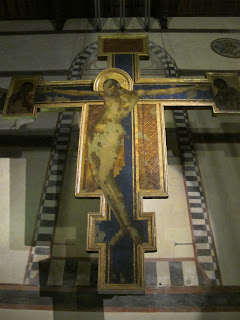 |
| Cimabue's partially restored crucifix in the Basilica of Santa Croce |
Travel tip:
The Basilica of Santa Croce, consecrated in 1442, is the
main Franciscan church in Florence and the burial place among others of
Michelangelo, Galileo, Machiavelli, the poet Ugo Foscolo, the philosopher
Giovanni Gentile and the composer Gioachino Rossini. It houses works by some of the most
illustrious names in the history of art, including Canova, Cimabue, Donatello,
Giotto and Vasari.

